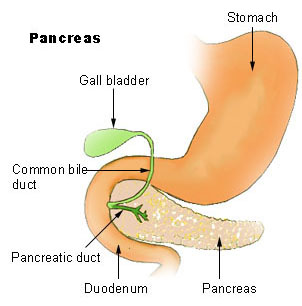Steapsin
|
WikiDoc Resources for Steapsin |
|
Articles |
|---|
|
Most recent articles on Steapsin |
|
Media |
|
Evidence Based Medicine |
|
Clinical Trials |
|
Ongoing Trials on Steapsin at Clinical Trials.gov Clinical Trials on Steapsin at Google
|
|
Guidelines / Policies / Govt |
|
US National Guidelines Clearinghouse on Steapsin
|
|
Books |
|
News |
|
Commentary |
|
Definitions |
|
Patient Resources / Community |
|
Directions to Hospitals Treating Steapsin Risk calculators and risk factors for Steapsin
|
|
Healthcare Provider Resources |
|
Causes & Risk Factors for Steapsin |
|
Continuing Medical Education (CME) |
|
International |
|
|
|
Business |
|
Experimental / Informatics |
Steapsin belongs to the class of digestive enzymes called lipases found in the pancreatic juice that catalyzes the hydrolysis of triglycerides (main constituent in vegetable oils and animal fat) to fatty acids and glycerol. When food travels through the oral cavity and down the esophagus into the stomach, enzymes such as pepsin are released where it cleaves large proteins into smaller peptide fragments so further digestion and absorption can occur in the duodenum, the tube that connects the stomach to the small intestine. Fats are minimally digested in the stomach by gastric lipases but most digestion occurs in the small intestine.

Function
The lipase steapsin is secreted from the pancreas to break down triglycerides to liberate the fatty acids and glycerol. The free fatty acids can then be absorbed to the liver and kidneys where it may be converted to glyceraldehyde 3-phosphate, a constituent in the process of glycolysis to ultimately generate energy in the form of ATP via the citric acid cycle. Fatty acids that are not used for energy can then be allowed to cross the intestinal barrier to be repackaged into fatty tissue.
Characterization
Previous studies have shown some physical characteristics of steapsin. Throughout this experiment, steapsin was found to be inherently unstable and will degrade naturally.
Method
To quantify the activity of steapsin in vitro, olive oil was used as the fat (triglycerides) to be broken down. Steapsin was added and various experiments were conducted which thus digested olive oil to form glycerol and free fatty acids. The free fatty acid formation caused the mixture to turn acidic, thus phenolphthalein indicator was added and the mixture was titrated against 0.1M NaOH. Therefore, the steapsin activity correlates to the amount of NaOH added, and subsequent experiments can be quantified and compared this way. To simulate the factors of the stomach, all experiments were carried out at 40 C.
pH stability
Under basic (done by adding 0.12 M sodium carbonate until pH 11) and neutral conditions, steapsin activity decreased by 10% per hour. Under acidic conditions, it was discovered that only a small quantity of free hydrochloric acid (approximately 0.02M) was required to diminish the lipolytic activity of steapsin by 80% in the first hour. This suggests that steapsin is inactivated by acid and is present in the small intestines and not the stomach.
Temperature
After steapsin was subject to separate time course experiments heated to various temperatures, the lowest rate at which steapsin activity degraded was at 37C.
• 37 C – 8% degradation per hour
• 40 C – 10% degradation per hour
• 50 C – 99% degradation per hour
• 60 C – 99% degradation in 10 minutes
Inhibitors
Trypsin
Trypsin protease (enzyme that digests protein) and functions as a steapsin inhibitor. Trypsin is produced in the pancreas and secreted as trypsinogen, an inactive precursor of trypsin. The reason for this is to prevent trypsin from acting upon the pancreas. Upon entering the duodenum, enteropeptidase is secreted which activates trypsin. Since trypsin is classified as a protease, its function in the gastric tract is to act as a steapsin suppressor by digesting steapsin.
Anti-inhibitors
Egg Albumen
Egg albumen (egg whites) acts as a trypsin inhibitor because egg whites are full of protein which allows trypsin to act upon the egg whites instead of steapsin. This allows the trypsin to be neutralized and allows steapsin's activity to remain unchanged.
Conclusions
When eating greasy foods: - Eat protein (e.g. egg whites, lean meat) to allow steapsin to remain active for a longer period to break down triglycerides. - Remember to expend the energy from these fatty acids to prevent it from being incorporated into adipose tissue.